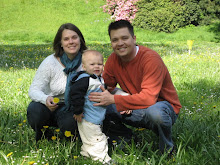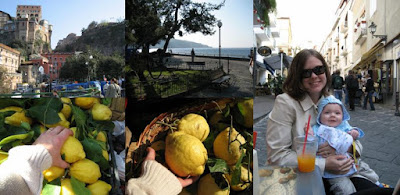 After successfully finding the hotel and grabbing a bite to eat, we headed to the Eiffel Tower. It’s so much bigger than I imagined it; truly pictures don’t do it justice. It is unbelievably beautiful and probably the most famous structure in the world. We did some more sightseeing and then went back for a ride to the top at sunset.
After successfully finding the hotel and grabbing a bite to eat, we headed to the Eiffel Tower. It’s so much bigger than I imagined it; truly pictures don’t do it justice. It is unbelievably beautiful and probably the most famous structure in the world. We did some more sightseeing and then went back for a ride to the top at sunset. In between our two Eiffel Tower visits, we visited some more famous landmarks. First was Notre Dame. As you can see, the cathedral is decorated with thousands of intricately detailed carvings, each with their own symbolic meaning. We didn’t stay long enough to try and figure out what those meanings are, but now know enough to bluff our way by most. Technically, pictures inside are not allowed, but there were so many others taking pictures, I thought I might as well give it a try. I was able to get a decent shot of one of the rose windows. They’re absolutely gorgeous. The day was quite warm, so I ended up stripping Jacob down to his onesie as you can tell by his bare legs. No shoes and no pants – a little trashy, but at least he was comfortable.
In between our two Eiffel Tower visits, we visited some more famous landmarks. First was Notre Dame. As you can see, the cathedral is decorated with thousands of intricately detailed carvings, each with their own symbolic meaning. We didn’t stay long enough to try and figure out what those meanings are, but now know enough to bluff our way by most. Technically, pictures inside are not allowed, but there were so many others taking pictures, I thought I might as well give it a try. I was able to get a decent shot of one of the rose windows. They’re absolutely gorgeous. The day was quite warm, so I ended up stripping Jacob down to his onesie as you can tell by his bare legs. No shoes and no pants – a little trashy, but at least he was comfortable. Across the street from Notre Dame, we enjoyed our first taste of authentic Parisian cuisine – crepes with caramel sauce. They were delicious and the best ones we had the entire trip!
Across the street from Notre Dame, we enjoyed our first taste of authentic Parisian cuisine – crepes with caramel sauce. They were delicious and the best ones we had the entire trip! After crepes, we headed for the Arc de Triomphe and the Champs Elysees. The Arc is in the middle of a traffic circle where about 5 streets converge. It’s quite impressive and makes the roundabout in our neighborhood look like a playground. As you can see, this was one of Jacob’s favorite stops on the trip.
After crepes, we headed for the Arc de Triomphe and the Champs Elysees. The Arc is in the middle of a traffic circle where about 5 streets converge. It’s quite impressive and makes the roundabout in our neighborhood look like a playground. As you can see, this was one of Jacob’s favorite stops on the trip. The Champs Elysees is the famous avenue where all the pricey shops are located. We took a stroll down the street but didn’t make it into any of the boutiques. It was fun to window shop and fantasize. Maybe one day I’ll actually go into one of those stores; I doubt it though, it would give Dustin heartburn…
The Champs Elysees is the famous avenue where all the pricey shops are located. We took a stroll down the street but didn’t make it into any of the boutiques. It was fun to window shop and fantasize. Maybe one day I’ll actually go into one of those stores; I doubt it though, it would give Dustin heartburn… We had dinner on the Champs Elysees at a restaurant that had an outside eating area. There were to young ladies sitting at the table next to us, and for about 20 minutes, Jacob decided he was a part of their conversation. It was so cute! He was leaning over in his stroller with his elbow resting on the side and his legs crossed. The picture below doesn’t quite capture all of it, but you get the idea. What a nosey little fellow! A flirt, too!
We had dinner on the Champs Elysees at a restaurant that had an outside eating area. There were to young ladies sitting at the table next to us, and for about 20 minutes, Jacob decided he was a part of their conversation. It was so cute! He was leaning over in his stroller with his elbow resting on the side and his legs crossed. The picture below doesn’t quite capture all of it, but you get the idea. What a nosey little fellow! A flirt, too! After dinner we went back to the Eiffel Tower to get a view of the city and a night shot of the Tower. Magnificent!
After dinner we went back to the Eiffel Tower to get a view of the city and a night shot of the Tower. Magnificent!The next day, we headed to the Louvre (left). We saw all the highlighted items – the Mona Lisa, the Winged Victory, the Venus de Milo, the Virgin of the Rocks, and a few more. We could have spent a week there and still not have seen everything, so we did the whirlwind tour instead. The Louvre was quite crowded and noisy as opposed to the Musee d’Orsay which we hit next. This museum is home to the Impressionists – Monet, Renoir, Cezanne, Van Gogh and more. I think Monet is my favorite. His work is so peaceful.
 After the museums, we headed out to Versailles. It’s about a 20 minute train ride from Paris. A friend of mine was visiting her parents who now live in Versailles, so I wanted to head there to meet up with her for dinner. We took the audio tour of the Chateau which was quite interesting (I would recommend it). Talk about living in excess! The rooms are all ornately decorated: trimmed in gold, paintings everywhere, crystal chandeliers, etc. The gardens are quite impressive as well. The two disappointments were that the Chateau is under heavy restoration projects right now, so there was scaffolding everywhere (hard to get good pictures) and none of the fountains were on in the gardens. Apparently, they are on a schedule and put on a little show accompanied by music at certain times each day. We didn’t get to see that. Still, the visit was wonderful and well worth the train ride. Jacob had fun, too!
After the museums, we headed out to Versailles. It’s about a 20 minute train ride from Paris. A friend of mine was visiting her parents who now live in Versailles, so I wanted to head there to meet up with her for dinner. We took the audio tour of the Chateau which was quite interesting (I would recommend it). Talk about living in excess! The rooms are all ornately decorated: trimmed in gold, paintings everywhere, crystal chandeliers, etc. The gardens are quite impressive as well. The two disappointments were that the Chateau is under heavy restoration projects right now, so there was scaffolding everywhere (hard to get good pictures) and none of the fountains were on in the gardens. Apparently, they are on a schedule and put on a little show accompanied by music at certain times each day. We didn’t get to see that. Still, the visit was wonderful and well worth the train ride. Jacob had fun, too! The next morning, we had a leisurely breakfast and walked through some shops looking for souvenirs. Then, we headed back to the train station for the trip home. It’s amazing. We didn’t have much time in Paris, but we sure did see a lot. Jacob was exhausted!
The next morning, we had a leisurely breakfast and walked through some shops looking for souvenirs. Then, we headed back to the train station for the trip home. It’s amazing. We didn’t have much time in Paris, but we sure did see a lot. Jacob was exhausted!





 Maastricht is the only place in Holland whose landscape has some contour. While the hills are pretty small, it is still a welcome sight from the north. If you have been following the blog, then you can look at Holland as the geographical antithesis to Sorrento.
Maastricht is the only place in Holland whose landscape has some contour. While the hills are pretty small, it is still a welcome sight from the north. If you have been following the blog, then you can look at Holland as the geographical antithesis to Sorrento. As you can see from the pictures, even the people of Maastricht knew better than to let me into the city. I knocked, pulled, and yelled, but still no one answered. That probably comes as no surprise to most of you…
As you can see from the pictures, even the people of Maastricht knew better than to let me into the city. I knocked, pulled, and yelled, but still no one answered. That probably comes as no surprise to most of you…
 On Saturday morning we got up around 9am (early by European standards) and embarked on the Maastricht city walk. It was kind of like the Freedom Trail in Boston. You followed the “red-line” on the map and walked passed all the historical sites. Most of the sites had an information plaque telling you why it was famous. The only difference is all the plaques were in Dutch. Needless to say, we didn’t learn much on the walk (but, we did enjoy the sites).
On Saturday morning we got up around 9am (early by European standards) and embarked on the Maastricht city walk. It was kind of like the Freedom Trail in Boston. You followed the “red-line” on the map and walked passed all the historical sites. Most of the sites had an information plaque telling you why it was famous. The only difference is all the plaques were in Dutch. Needless to say, we didn’t learn much on the walk (but, we did enjoy the sites). Probably the best part of the trip (for me) was Fort St. Peter and the Caves. In the past Maastricht was a strategic city because of its proximity to Germany, France, and Belgium. Based on the stories, Maastricht seemed to be under a constant siege from 1200 – WWII.
Probably the best part of the trip (for me) was Fort St. Peter and the Caves. In the past Maastricht was a strategic city because of its proximity to Germany, France, and Belgium. Based on the stories, Maastricht seemed to be under a constant siege from 1200 – WWII.
 We left Maastricht Sunday morning and decided to drive back home via a different route. This time we drove through Belgium and stopped in Antwerp for lunch. By luck, we parked just a block from the town center.
We left Maastricht Sunday morning and decided to drive back home via a different route. This time we drove through Belgium and stopped in Antwerp for lunch. By luck, we parked just a block from the town center. We ended our short time in Antwerp by eating lunch at a local Italian restaurant. The food was delicious!
We ended our short time in Antwerp by eating lunch at a local Italian restaurant. The food was delicious!

















